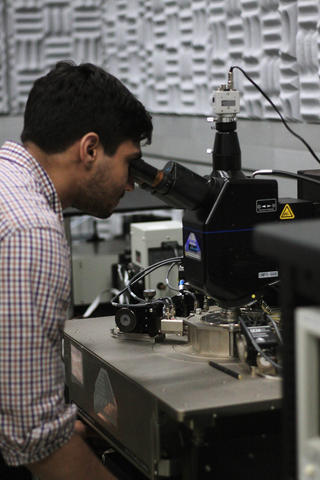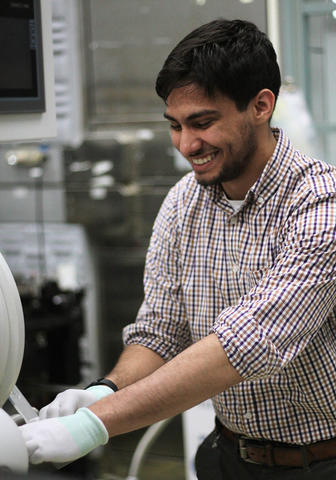Taking Measure
Just a Standard Blog

Samuel Márquez Gonzalez’s research may help increase the efficiency of solar cells — devices that convert sunlight into electricity and are used in solar panels.
When I was a child, I loved video games. I used to spend hours playing them on my old computer and my Nintendo DS. My parents limited my hours so I would concentrate more on my classes. But I always found a way to continue playing in secret.
I loved Pokémon. When I was playing, I wanted to know how much power I had and how I could use math to take out my enemies. Knowing the strength of my attacks and the enemy’s defenses, I tried to calculate how much damage I could do. I was never able to perfectly predict the amount of damage, but this mindset got me into math and playing with numbers.
My childhood focus on video games helped me get to where I am today — doing research at NIST as part of the Professional Research Experience Program (PREP).
‘Exciting’ Research
My research project at NIST focuses on devices known as transistors, which amplify electricity in our electronic gadgets. I specifically work with organic transistors, which are made of carbon-based semiconductors. Basically, carbon-based semiconductors have the potential to make our electronic devices more energy efficient. It’s fascinating and complex work.
I’m investigating a process that can occur in organic semiconductors, known as singlet fission. Before we can understand singlet fission, we need to know about the key character (or characters) in our story — an exciton. An exciton is a pairing of an electron and a “hole,” a place where an electron could be but isn’t.
Singlet fission happens when an organic semiconductor molecule absorbs light. During the process, one exciton becomes two excitons, but the two excitons only have half the energy of the original exciton. Eventually, these excitons break down into individual electrons and holes, becoming part of the electric current.
Understanding singlet fission can be useful for increasing the efficiency of solar cells — devices that convert sunlight into electricity and are used in solar panels. In solar cells, singlet fission can help light turn into electricity with greater efficiency. Singlet fission may also be useful for quantum computing and other forms of quantum information.
In my project, we use an electromagnet to change the number of excitons produced during singlet fission, which can mean more energy is produced. At NIST, this process has recently been used to make a device that measures magnetic fields. We are working to understand these concepts better to increase the performance of organic transistors.
If we’re successful, we could make solar cells more powerful or improve quantum computing. So, this field is “exciting” in more ways than one!
In addition to the exciting research opportunities, I’ve met so many inspiring individuals at NIST. Notably, my mentors, Katelyn Goetz and Emily Bittle, have offered invaluable guidance as I navigate the initial stages of my research career.
Physics and Perseverance
I moved from my home in Venezuela to Brazil in 2016, when I was 13. It was scary for me to start a new life in a different place, but I adapted quickly.
My native language, Spanish, and Brazil’s official language, Portuguese, are very similar. So, it was easy for me to learn the language and adapt to Brazilian culture.

In Brazil, I had the opportunity to meet amazing teachers in high school who introduced me to mathematics and physics. I remember that, in the same way that I used to play with numbers, I started to play with physics after school. I used to make up questions like, “How strong should a force be to push a six-floor building around the equator in 16 seconds?” These questions made no sense, but they were fun to solve!
Then, I moved with my family back to Venezuela. In 2019, the “big blackout” happened, and much of the country was without power for weeks. I left with my family for the U.S. and never returned. I always say that this is the longest trip that I ever had.
We moved to Maryland because my sister was living here before we arrived. I started studying at Montgomery College. Because English is not my native language, I first had to take multiple semesters of English language classes. These were complicated because, unlike Portuguese, English is very different from Spanish. However, I was determined to keep advancing. After completing those semesters, I decided to study physics because that is what I have been interested in since I used to play Pokémon.
At Montgomery College, I was able to work toward my professional career goals. It also provided me with the fantastic opportunity to be at NIST through the PREP program.
As I reflect on the key moments in my life, I see how various countries have profoundly influenced my development. Venezuela shaped my childhood, and video games marked my fascination with numbers. Brazil defined my adolescence, introducing me to the wonders of math and physics during my high school years. Finally, the U.S. played a crucial role in my young adulthood, offering me opportunities for professional growth and a career in scientific research.
Perseverance has been a big part of my life. For example, when I was a teenager, I got interested in all different types of fitness. My parents always thought I wouldn’t stick with it, but I did. But whether it’s science or fitness, when I set a goal, I follow through. I’m not sure where exactly that comes from, but it’s a helpful quality to have when you work in science.
This innate grit has been especially beneficial in my scientific pursuits, a field that demands unwavering determination and patience. For example, our project requires a lot of data analysis. I often find myself spending long hours in my office because of this, which can be tedious. I try to be as patient as possible to be able to advance.
As I look forward to my future in physics, I am grateful for my journey so far — filled with video games, unexpected moves and a whole lot of mathematics and physics.
Looking Ahead to a Career in Science
As my next step, I am planning to transfer to the University of Maryland. I also want to look for more opportunities to advance my research career.
Although I’m currently authorized to work in the U.S., I hope one day I’ll be able to get citizenship, which would allow me to become a permanent researcher here at NIST. (It would also officially end my longest trip!)
Science is always moving forward each day, so I want to use any opportunity I find to get into the thick of this ever-evolving landscape. Whether it’s conducting research, attending seminars, presenting papers or contributing to collaborative projects, I am always on the lookout for chances to learn, grow and contribute to the field.
I would also love to see more young people like me taking advantage of opportunities, such as the PREP program. We need more young researchers to tackle the scientific challenges of tomorrow, and it is important to continue encouraging and inspiring the next generation to become part of this journey.
About the author
Related posts
Comments
You’ve had an amazing journey Samuel. Your attitude and desires for others is heart warming. All that is within and surrounds us is limitless and at our beckoning. Passion, as the energetic force, is the path that leads one to “Intending” what’s to come.






Salute to you Samuel, quite an interesting personal journey. Best of luck!!